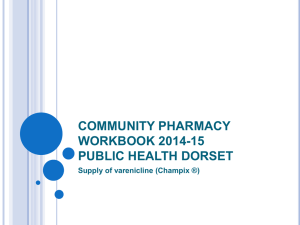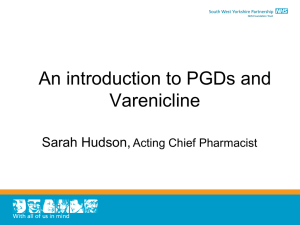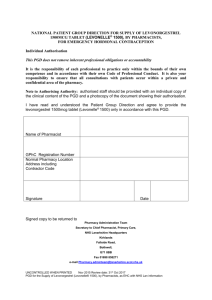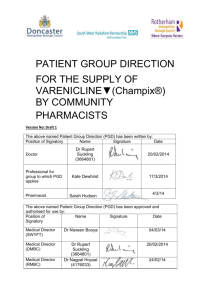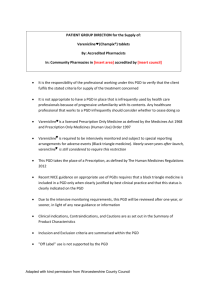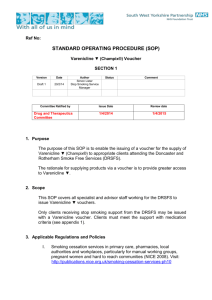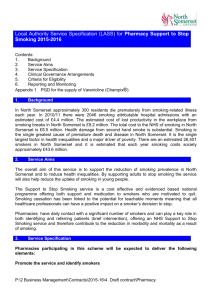Example varenicline PGD
advertisement
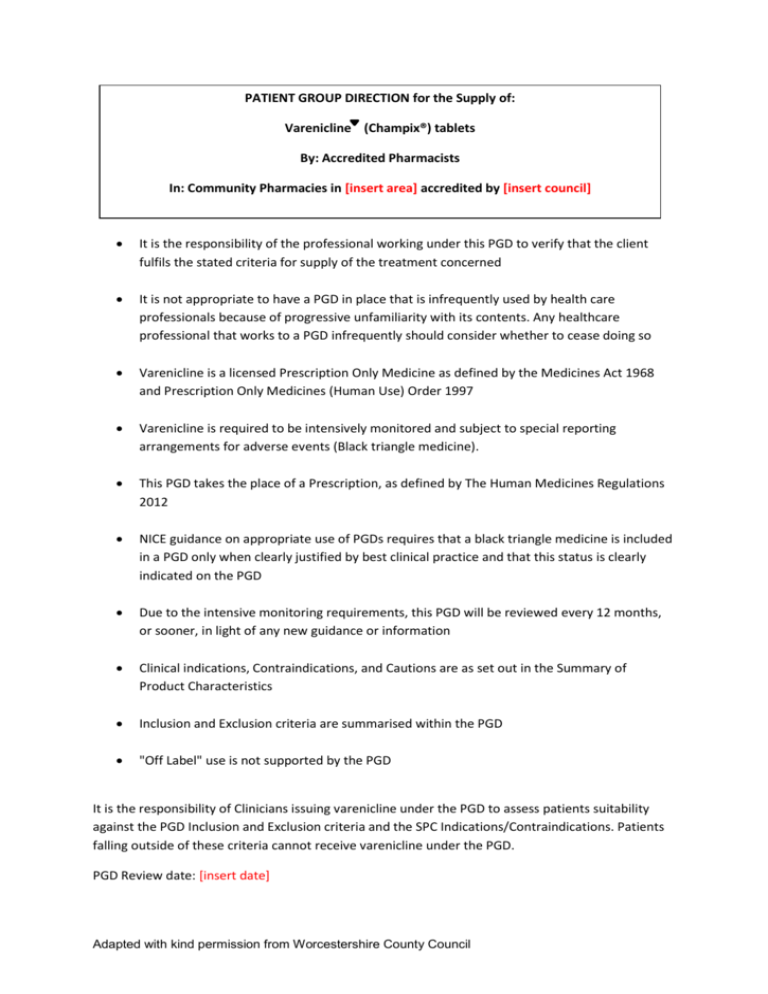
PATIENT GROUP DIRECTION for the Supply of: Varenicline (Champix®) tablets By: Accredited Pharmacists In: Community Pharmacies in [insert area] accredited by [insert council] It is the responsibility of the professional working under this PGD to verify that the client fulfils the stated criteria for supply of the treatment concerned It is not appropriate to have a PGD in place that is infrequently used by health care professionals because of progressive unfamiliarity with its contents. Any healthcare professional that works to a PGD infrequently should consider whether to cease doing so Varenicline is a licensed Prescription Only Medicine as defined by the Medicines Act 1968 and Prescription Only Medicines (Human Use) Order 1997 Varenicline is required to be intensively monitored and subject to special reporting arrangements for adverse events (Black triangle medicine). This PGD takes the place of a Prescription, as defined by The Human Medicines Regulations 2012 NICE guidance on appropriate use of PGDs requires that a black triangle medicine is included in a PGD only when clearly justified by best clinical practice and that this status is clearly indicated on the PGD Due to the intensive monitoring requirements, this PGD will be reviewed every 12 months, or sooner, in light of any new guidance or information Clinical indications, Contraindications, and Cautions are as set out in the Summary of Product Characteristics Inclusion and Exclusion criteria are summarised within the PGD "Off Label" use is not supported by the PGD It is the responsibility of Clinicians issuing varenicline under the PGD to assess patients suitability against the PGD Inclusion and Exclusion criteria and the SPC Indications/Contraindications. Patients falling outside of these criteria cannot receive varenicline under the PGD. PGD Review date: [insert date] Adapted with kind permission from Worcestershire County Council 1. Purpose of the PGD For accredited pharmacists to supply varenicline within its licensed indications as an option for smokers who have expressed a desire to quit smoking and who will be supported and monitored within a pharmacy contracted to provide stop smoking services or may be referred to an accredited pharmacist by a [insert council] contracted local Stop Smoking Service. 2. Clinical condition or situation to which this PGD applies 2.1 Define condition/situation Varenicline as an option for clients wishing to quit smoking and who are being monitored in the pharmacy 2.2 Criteria for inclusion Clients over 18 years of age Tobacco users identified as sufficiently motivated to quit Tobacco users who are receiving support to stop smoking with a [insert council] contracted Stop Smoking Service A medical history is taken and documented to establish that there are no contraindications for treatment with varenicline and that any cautions for use are recorded (see Criteria for exclusion and Criteria for cautions). Refer to Appendix 1 for Assessment to Supply Varenicline 2.3 Criteria for exclusion Tobacco users not sufficiently motivated to quit or to use varenicline Clients under 18 years of age Sensitivity to varenicline or any of its excipients Pregnancy/ breastfeeding Client already receiving varenicline prescribed by GP Renal impairment or end stage renal disease as decreased clearance by kidney increases side effects. Epilepsy or history of fits or seizures Substance misuse patients Clients who have experienced serious or worrying side effects from a previous course of varenicline Clients with active or history of psychiatric illness should be referred to their GP The MHRA have warned that there is a possible link between varenicline and psychiatric adverse events, particularly agitation, depression, and suicidal ideation. There is no strong epidemiological evidence from the clinical trials or monitoring data to suggest a causal link and no putative pharmacological mechanism to suggest causality, but this PGD provides a framework Adapted with kind permission from Worcestershire County Council 2.4 Criteria for cautions [to include consideration of concurrent medication] that allows for safe supply in the context of this warning. Smoking cessation, with or without pharmacotherapy, has been associated with the exacerbation of underlying psychiatric illness (e.g. depression). Clients with a history of psychiatric illness should be referred to their GP. Cigarette smoke stimulates a liver enzyme responsible for metabolising some medicines in the body, such as theophylline, warfarin and insulin, meaning that the metabolism of these medications increases. Patients should be warned that physiological changes resulting from smoking cessation, with or without treatment with varenicline, may alter the pharmacokinetics or pharmacodynamics of some medicinal products for which dose adjustment may be necessary. 2.5 Client consent [verbal, written, implied] 2.6 Action if client excluded If a client is a diabetic or is taking theophylline/aminophylline or warfarin, ensure their GP is notified of their quit attempt/use of varenicline using the letter provided with this PGD. (see appendix 3) When the client stops smoking, metabolism of theophylline is reduced which could cause plasma theophylline levels to rise, possibly to toxic levels if the dose of theophylline is not adjusted. Signs of theophylline toxicity are: - vomiting, dilated pupils, sinus tachycardia and hyperglycaemia Patients on Warfarin, should advise the clinic of their intention to quit smoking using varenicline when they next attend for a blood test Patients on insulin may be supplied with varenicline. However they should be advised to monitor their blood glucose levels closely Informed consent as stated in the local consent policy, including consent to the use of the PGD, and informing GP of supply of varenicline Pharmacists providing [insert council] contracted Stop Smoking Services should offer clients the option of NRT or refer the client to their GP (see Appendix 2). This might include any of the conditions referred to as exclusion criteria above, but also previously unrecognised co-morbidities. Adapted with kind permission from Worcestershire County Council Other pharmacists should direct the client back to their original [insert council] contracted Stop Smoking Service Provider. 2.7 Action if treatment declined by client Document action in client’s medication record (PMR) and smoking cessation monitoring form. Pharmacists providing [insert council] contracted Stop Smoking Services should offer other available smoking cessation options if appropriate. Other pharmacists should direct the client back to their original [insert council] contracted Stop Smoking Service Provider. Document action in client’s medication record (PMR) and inform the Service Provider of the outcome 3. Characteristics of staff 3.1 Class of healthcare professional for whom PGD is applicable & professional qualifications required Pharmacist registered with General Pharmaceutical Council, working within and for a pharmacy with an agreement with [insert council] to provide varenicline under PGD. Must have completed the [insert detail] varenicline training programme. 3.2 3.3 Additional requirements/ specialist qualifications required Continued training requirements 4. Description of treatment 4.1 Generic name of medicine and form (e.g. tablets) 4.2 Legal status POM/P/GSL This PGD will only apply whilst the pharmacist is employed or contracted/working at the time in an accredited Pharmacy within [insert local details]. Pharmacist has undertaken appropriate training to carry out clinical assessment of clients to provide most effective and safe option according to the indications listed in this PGD. Accredited pharmacies will have a suitable private consultation room / area which is available for all client consultations. The practitioner should be aware of any change to the recommendations for the medicine listed. It is the responsibility of the individual to keep up-to-date with continued professional development and to work within the limitations of individual scope of practice. Varenicline (Champix®) 0.5mg and 1mg tablets POM – subject to intensive monitoring requirements (Black Triangle Drug) Adapted with kind permission from Worcestershire County Council 4.3 Licensed or unlicensed use [If unlicensed state rationale for use] Dose [Where a range is applicable include criteria for deciding on a dose] Licensed Days 1 – 3: 0.5 mg (white tablets) once daily Days 4 – 7: 0.5 mg twice daily Day 8 to the end of treatment (normally 12 weeks in total): 1 mg (light blue tablets) twice daily Note: The quit date is often on day 8 of taking varenicline. Patients who cannot tolerate the adverse effects of varenicline can have the dose lowered temporarily or permanently to 0.5 mg twice daily. (See BNF 4.10.2) Lower dose to end of treatment (normally 12 weeks in total): 0.5 mg (white tablets) twice daily 4.4 Route / method of administration Frequency Oral 4.6 Total dose and number of times treatment can be administered; state time frame 4.7 Information on follow-up management Written/verbal advice for client before/after treatment and management Clients should be supplied a 14 day initiation pack and should set a quit date 7 to 14 days after initiation Clients should be seen weekly for at least 4 weeks after the quit date, then fortnightly Only 14-day prescription packs should be used throughout the quit attempt The normal treatment course is 12 weeks Advise to seek medical advice if more severe reactions to medication occur Clients should be advised to set a quit date 7 to 14 days after initiation The major reasons for varenicline failure are: - Unrealistic expectations - Unable to tolerate side-effect of nausea - Insufficient or incorrect use It is important to make sure that the client understands the following points: 1. Varenicline is an effective medication but effort and determination are also necessary 2. It works by acting on the parts of the brain which are affected by nicotine in 4.5 4.8 Once daily for the first three days, then twice daily thereafter Adapted with kind permission from Worcestershire County Council 4.9 Communication with client’s General Practitioner 4.10 Communication with client’s [insert council] contracted Stop Smoking Service Provider 4.11 Instructions on identifying, managing & reporting adverse drug reactions cigarettes 3. It does not remove all temptation to smoke, but it does make abstinence easier 4. Varenicline is safe, but about a third of clients may experience mild nausea some 30 minutes after taking it. This reaction usually diminishes gradually over the first few weeks, and most clients tolerate it without problems. If client is unable to tolerate due to nausea refer to GP for full review and/or dose reduction 5. Instruct on correct use and daily dose. Use mock product packaging for the explanation. Clients should take varenicline for 7 to 14 days before stopping smoking At the end of treatment, discontinuation of varenicline has been associated with an increase in irritability, urge to smoke, depression, and/or insomnia in up to 3% of clients. The pharmacist should inform the client accordingly and discuss or consider the need for dose tapering No clinically significant drug interactions have been reported In every case when the initial supply of varenicline is made in accordance with this PGD, the pharmacist must inform the client’s General Practitioner of the supply within two working days. This applies whether the pharmacy is a [insert council] contracted Stop Smoking Service Provider or not. Where the pharmacy is not the client’s [insert council] contracted Stop Smoking Service Provider, the pharmacist should also inform the Service Provider within two working days of the initial supply. For clients experiencing mild adverse effects after dose increase to 1mg twice daily, and where this is interfering with the quit attempt, consider a temporary or permanent dose lowering to 0.5 mg twice daily. (See BNF 4.10.2) Review at next scheduled appointment. Smoking cessation with or without treatment is associated with various symptoms. For example, dysphoria or depressed mood; insomnia, irritability, frustration or anger; anxiety; difficulty concentrating; restlessness; Adapted with kind permission from Worcestershire County Council decreased heart rate; increased appetite or weight gain have been reported in clients attempting to stop smoking. No attempt has been made in either the design or the analysis of the CHAMPIX studies to distinguish between adverse events associated with study drug treatment or those possibly associated with nicotine withdrawal. Clients should be asked at every appointment about their mood. If the client develops suicidal thoughts or behaviour they should be told to stop treatment and contact their GP immediately. Where the pharmacy is not the client’s [insert council] contracted Stop Smoking Service Provider, the pharmacist should also inform the Service Provider. If the client, family or care givers have concerns about agitation, depressed mood or changes in behaviour varenicline should be stopped immediately. Please refer to current BNF and SPC for full details. Varenicline is required to be intensively monitored and subject to special reporting arrangements for adverse events (Black triangle medicine) – The pharmacist is required to report all adverse reactions to the CSM via yellow card system. 4.12 Arrangements for referral for medical advice 4.13 Precautions, facilities & supplies 4.14 Specify method of recording supply sufficient to enable audit trail Pharmacist must be able to advise client/parent/carer what action to take in the event of the client experiencing any side effects and the most appropriate action (e.g. dose reduction or medical service to contact. Store in a cool dry place. Order supplies from licensed pharmacy wholesalers. Client notes (Manual, Computerised, Client Held): Client’s name, address, date of birth and GP details. Referring [insert council] contracted Stop Smoking Service Provider. Date supplied and name of the pharmacist who supplied the medication. Batch number and expiry date. Reason for inclusion. Advice given to client. Adapted with kind permission from Worcestershire County Council Details of any adverse drug reaction and actions taken including documentation in the client’s medical record via GP (as well as reporting to the CSM using the ‘Yellow Card’ reporting system. 5. Audit The use of this PGD to be monitored by the service in which it is used. 6. Management 6.1 PGD group [Insert name, job title and organisation of PGD group members] 6.2 Authorisation This PGD has been approved on behalf of [insert council] by: [complete boxes below as per local requirements] Job title Name Signature Date 6.3 Persons permitted to authorise staff they are responsible for to operate this PGD Commissioning Manager for the County Council or Deputy 7. References and Sources of Information Service Specification Current edition of the British National Formulary Manufacturer’s Summary of Product Characteristics PGD for administration of varenicline tablets by Community Pharmacists within [insert area] It is the responsibility of the Authorising Person to keep this list up to date and in a safe place for reference. Any healthcare professionals who no longer meets the competency requirements or leave the service or practice must be removed from the list; likewise, any new healthcare professionals meeting the competency requirements should be added to the list in order to work under the Patient Group Direction. The Authorising Person is only expected to confirm that the Healthcare Professionals meets the minimum training and competency requirements under this PGD. It is the responsibility of the Healthcare Professional themselves and their Professional Body to ensure that they are fit to practice. This Patient Group Direction is to be read, agreed to and signed by all healthcare professionals it applies to. The original signed copy should be retained by the Authorised Person with responsibility for PGDs within the pharmacy. A copy should be retained by each pharmacist. Adapted with kind permission from Worcestershire County Council I confirm that I have read and understood the content of this Patient Group Direction and that I am willing and competent to work under it within my professional code of conduct Healthcare Professionals permitted to supply or administer under this PGD Name of Signature Authorised Person with Signature Date Healthcare responsibility for PGDs: approved Professional Commissioning Manager (Pharmacist) or Deputy Adapted with kind permission from Worcestershire County Council Appendix 1 Pharmacist's Clinical Assessment to Supply Varenicline (Champix®) Client Name ______________________________ DOB _______________________ Client Address ________________________________________________________ ____________________________________________________________________ Name of referring [insert council] contracted Stop Smoking Service Provider (if applicable) ________________________________________________________________________________ Is the client sufficiently motivated to stop smoking? If no, DO NOT continue with this form or supply varenicline - advise the client to return when they are ready to make a quit attempt. Criteria for Exclusion Is the client sensitive to varenicline tartrate or any of its excipients? Is the client under 18 years old? Does the client have end-stage renal disease? Is the client pregnant? Is the client breastfeeding? Does the client have epilepsy? Does the client have a history of serious psychiatric illness? Yes No If the client answers yes to any of the above then varenicline may not be suitable. Other options available to the client are: direct client back to the referrer for consideration of other treatments, if applicable offer the option of NRT (if a WCC Contracted Stop Smoking Service Provider) refer client to their GP using the Notification Form in Appendix 2 If in doubt seek further advice from the client’s GP Name of Pharmacist: Signature: Adapted with kind permission from Worcestershire County Council Date: Appendix 2 Pharmacist referral to GP: patients excluded from varenicline PGD URGENT & CONFIDENTIAL FAX Pharmacy Stamp Data protection confidentiality note: this message is intended only for the use of the individual or entity to whom it is addressed and may contain information that is privileged, confidential and exempt from disclosure under law. If the reader of this message is not the intended recipient, you are hereby notified that any dissemination, distribution or copying of this communication is strictly prohibited. FAO: GP Name___________________________________________________ GP Address_________________________________________________ Notification of consultation and non-supply of varenicline Client’s Name ____________________________________________ Address ____________________________________________ ____________________________________________ DOB ___________ Telephone________________________ Dear Doctor A consultation has taken place with your patient in accordance with the [insert council] varenicline Patient Group Direction to assess whether it is appropriate for them to receive varenicline. However, no supply under the PGD has been made, due to the following being identified: (Summarise here details from assessment form (Appendix 1)) CONSENT I,____________________ (client name) confirm that the above information has been discussed with me and is an accurate record of that discussion. I give my consent to the above information to be passed to my GP. Signature:____________________________________ Date:________________ Appendix 3 Adapted with kind permission from Worcestershire County Council Pharmacist Notification to GP of supply of varenicline URGENT & CONFIDENTIAL FAX Pharmacy Stamp Data protection confidentiality note: This message is intended only for the use of the individual or entity to whom it is addressed and may contain information that is privileged, confidential and exempt from disclosure under law. If the reader of this message is not the intended recipient, you are hereby notified that any dissemination, distribution or copying of this communication is strictly prohibited. FAO: GP Name____________________________________________ GP Address___________________________________________ Notification of supply of varenicline Client’s Name ____________________________________________ Address ` ____________________________________________ ____________________________________________ DOB _______________ Telephone____________________ Dear Doctor I write to advise you that your patient has been seen by me for smoking cessation treatment. They have expressed a wish to use varenicline to aid their effort in stopping smoking, and a medical history has taken place to assess whether it is appropriate for them to receive it. I have ascertained that your patient does not have any contraindications, or risk factors, for taking varenicline and meets the criteria for a supply to be made under the local Patient Group Direction. If you have any concerns about this person commencing varenicline then please do not hesitate to contact me. Name: ________________________________ Phone No: _______________ Signature: ______________________________Date: ___________________ Client is receiving varenicline from this pharmacy: Name of Pharmacy: _______________________________________________________ Address: ________________________________________________________________ Name of Stop Smoking Service (if different) ____________________________________ Address: ________________________________________________________________ Please note medical records may need updating if there is a change in the patient’s smoking status – remember to Read code. Adapted with kind permission from Worcestershire County Council
